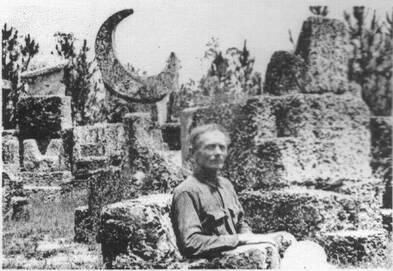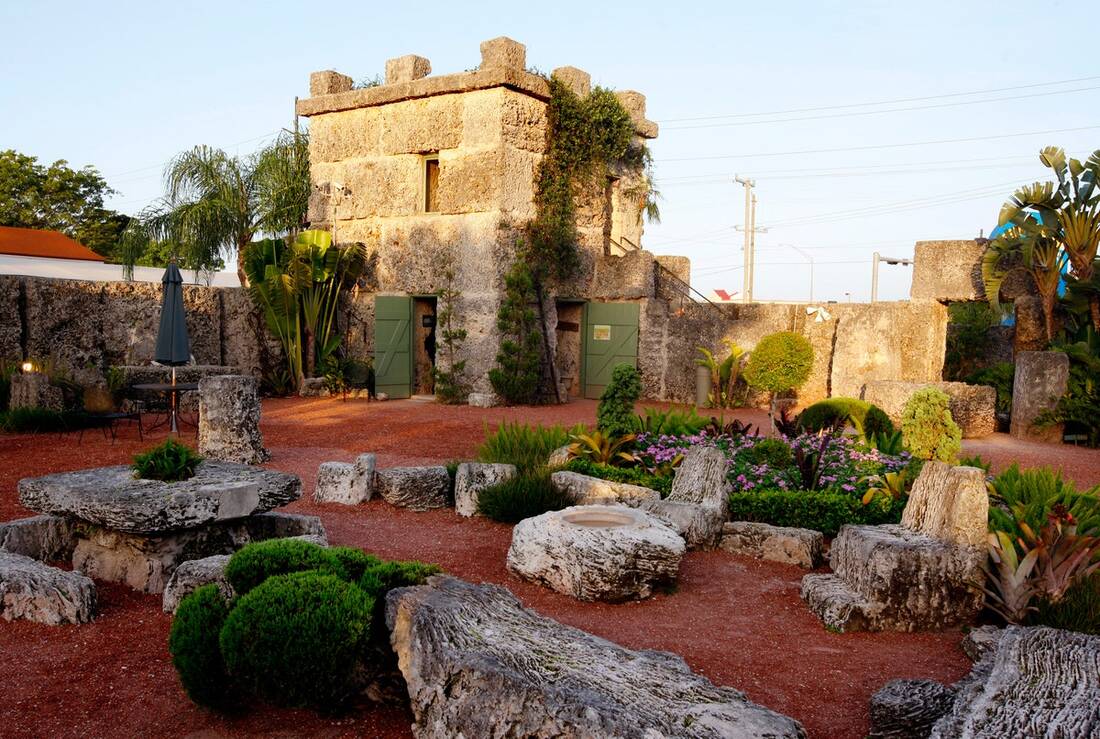Edward Leedskalnin and his Mysterious Coral Castle

Edward Leedskalnin (Edvards Liedskalnins), 26, left his native Latvia in 1912, when his 16-year-old fiancée Agnes Skuvst called off their wedding only the day before the nuptials.
He immigrated to America and first went to California, and by 1921, he settled in south Florida where he worked at a small grove. He said that he contracted tuberculosis, but by using magnets he healed himself from the disease.
As early as 1932, newspapers were writing articles about the "little Latvian" who was building a great "Caveman Castle" in Florida City. He spent 28 years building what he called Ed's Place, and which later became known as Coral Castle.
He carved thrones, stars and crescent moons from the oolitic limestone bedrock found in the Redland district, which was an isolated agricultural belt of southwest Dade county.
Some of the stone he used weighed as much as 15 tons. Leedskalnin dug them out, carved and moved them by himself. He only weighed 120 pounds.
He said that he was building his "Garden of Eden" in hopes that one day Agnes would change her mind, and come join him.
It was reported that four men could not lift the smallest piece that he brought to the castle. Allegedly he used the engineering skill of leverage, and the ones that "built the pyramids by man power alone." His tools were rock ax, crowbar and sledge hammer.
All the walls were two and half feet thick, and there was no cement used in the construction.
Ed never allowed anyone to see him while he was working, and many time worked at night using only a light from a lamp.
In 1936, he decided to move it to its present location in Leisure City on South Dixie Highway. It took him three years to move his creation 10 miles to the new site.
He then renamed it "Rock Gate". Ed continued to work on it until his death in 1951.
Originally Ed charged 10 cents for a tour of Ed's Place, and then once he went to Leisure City he would ask for donations of 25 cents.
During these years Ed lived on the premises on the second floor in the castle tower. When asked how he built the structure he would say, "It's not difficult if you know how." The answer he would give when he was asked why he built it, would be vague and make reference to his "Sweet Sixteen". According to a Latvian account the girl's real name was Hermine Lusis.
He immigrated to America and first went to California, and by 1921, he settled in south Florida where he worked at a small grove. He said that he contracted tuberculosis, but by using magnets he healed himself from the disease.
As early as 1932, newspapers were writing articles about the "little Latvian" who was building a great "Caveman Castle" in Florida City. He spent 28 years building what he called Ed's Place, and which later became known as Coral Castle.
He carved thrones, stars and crescent moons from the oolitic limestone bedrock found in the Redland district, which was an isolated agricultural belt of southwest Dade county.
Some of the stone he used weighed as much as 15 tons. Leedskalnin dug them out, carved and moved them by himself. He only weighed 120 pounds.
He said that he was building his "Garden of Eden" in hopes that one day Agnes would change her mind, and come join him.
It was reported that four men could not lift the smallest piece that he brought to the castle. Allegedly he used the engineering skill of leverage, and the ones that "built the pyramids by man power alone." His tools were rock ax, crowbar and sledge hammer.
All the walls were two and half feet thick, and there was no cement used in the construction.
Ed never allowed anyone to see him while he was working, and many time worked at night using only a light from a lamp.
In 1936, he decided to move it to its present location in Leisure City on South Dixie Highway. It took him three years to move his creation 10 miles to the new site.
He then renamed it "Rock Gate". Ed continued to work on it until his death in 1951.
Originally Ed charged 10 cents for a tour of Ed's Place, and then once he went to Leisure City he would ask for donations of 25 cents.
During these years Ed lived on the premises on the second floor in the castle tower. When asked how he built the structure he would say, "It's not difficult if you know how." The answer he would give when he was asked why he built it, would be vague and make reference to his "Sweet Sixteen". According to a Latvian account the girl's real name was Hermine Lusis.
 Ed Leedskalnin posed at Coral Castle
Ed Leedskalnin posed at Coral Castle
In November, 1951, Leedskalnin left a sign on the front gate "going to the hospital". He boarded a bus to Jackson Memorial Hospital, and it was determined he suffered a stroke before or when he arrived at the hospital. He died of kidney infection 28 days later. He was 64 years old, and his death certificate notes his death was caused by "uremia, failure of kidneys, as a result of the infection and abscess."
Ed died December 10, without a clear will, and his property went to a nephew named Henry living in Michigan. Among Ed's things were $3,500 cash which are equivalent to $35K in 2020. Another story reported he left behind $28,500 with a will indicating it should be divided equally among his nephews, but he didn't name them. About six of them came to court asking for the money. Some of them had not even met before.
According to Coral Castle's website, Henry (a nephew) inherited the property. His full name was Harijs Rudolfs Liedskalnins, and he was Ed's grand nephew. He died in 1956, and shortly before his demise he sold the property to a family in Illinois. However another story that circulates about the ownership notes that Julius Levin, a retired jeweler from Chicago, bought the land in 1952 from the State of Florida.
The new owners changed the name to Rock Gate Park and then to Coral Castle, and ran it as a tourist attraction.
In 1981, it was sold to its present owner which is Coral Castle Inc for $175K. In 1984, it was listed on the National Register of Historic Places.
Visitors to Coral Castle say that Ed haunts the grounds of his masterpiece. The general manager believes Ed is found mostly inside his tower bedroom. An EVP taken by a paranormal team recorded a voice asking, "Where is my bicycle?" The manager said that not too many people knew that Ed's bike disappeared shortly after his death.
In 1986, Billy Idola composed a song titled "Sweet Sixteen" inspired by Ed and his supposedly true love.
Despite claims that Ed was able to move approximately 1,100 tons of rock because he understood the dynamics of physics, no certain evidence has been provided or reproduced to explain his feat.
Ed died December 10, without a clear will, and his property went to a nephew named Henry living in Michigan. Among Ed's things were $3,500 cash which are equivalent to $35K in 2020. Another story reported he left behind $28,500 with a will indicating it should be divided equally among his nephews, but he didn't name them. About six of them came to court asking for the money. Some of them had not even met before.
According to Coral Castle's website, Henry (a nephew) inherited the property. His full name was Harijs Rudolfs Liedskalnins, and he was Ed's grand nephew. He died in 1956, and shortly before his demise he sold the property to a family in Illinois. However another story that circulates about the ownership notes that Julius Levin, a retired jeweler from Chicago, bought the land in 1952 from the State of Florida.
The new owners changed the name to Rock Gate Park and then to Coral Castle, and ran it as a tourist attraction.
In 1981, it was sold to its present owner which is Coral Castle Inc for $175K. In 1984, it was listed on the National Register of Historic Places.
Visitors to Coral Castle say that Ed haunts the grounds of his masterpiece. The general manager believes Ed is found mostly inside his tower bedroom. An EVP taken by a paranormal team recorded a voice asking, "Where is my bicycle?" The manager said that not too many people knew that Ed's bike disappeared shortly after his death.
In 1986, Billy Idola composed a song titled "Sweet Sixteen" inspired by Ed and his supposedly true love.
Despite claims that Ed was able to move approximately 1,100 tons of rock because he understood the dynamics of physics, no certain evidence has been provided or reproduced to explain his feat.













